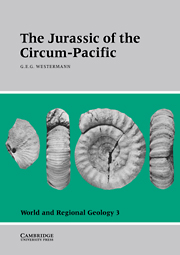Book contents
- Frontmatter
- Contents
- List of contributors
- Preface
- Acknowledgments
- Introduction
- Part I Time scales
- 1 Numerical time scale in 1988
- 2 Jurassic magnetic-polarity time scale
- Part II Circum-Pacific base map
- Part III Regional geology and stratigraphy
- Part IV Biochronology
- Part V Biogeography
- Part VI Climatology and oceanography
- Appendix: Biochronology and atlas with index and guide fossils
- General Index
- Index of Guide- and Indexfossils
2 - Jurassic magnetic-polarity time scale
Published online by Cambridge University Press: 04 August 2010
- Frontmatter
- Contents
- List of contributors
- Preface
- Acknowledgments
- Introduction
- Part I Time scales
- 1 Numerical time scale in 1988
- 2 Jurassic magnetic-polarity time scale
- Part II Circum-Pacific base map
- Part III Regional geology and stratigraphy
- Part IV Biochronology
- Part V Biogeography
- Part VI Climatology and oceanography
- Appendix: Biochronology and atlas with index and guide fossils
- General Index
- Index of Guide- and Indexfossils
Summary
The magnetic-polarity time scale for the Jurassic (Figure 2.1) has been compiled from several magnetostratigraphic studies. Correlation of the marine magnetic-anomaly M sequence with Lower Cretaceous and Upper Jurassic sediment sections has enabled assignment of precise biostratigraphic ages to the corresponding polarity chrons M0 through M25, as reviewed in Ogg (1988) and Ogg and Steiner (1988).
It has been suggested that the Cretaceous–Jurassic boundary (Berriasian–Tithonian boundary) be defined as the base of reversed-polarity chron M18r (Ogg and Lowrie 1986). The Tithonian and Kimmeridgian stages have been correlated to Tethyan ammonite zones in the Spanish Subbetic (Ogg et al. 1984), enabling the assignment of the Tithonian–Kimmeridgian boundary to approximately polarity chron M22A. The Kimmeridgian–Oxfordian boundary is near polarity chron M25. Therefore, polarity chrons corresponding to marine magnetic anomalies M26 through M28 should have a Late Oxfordian age. There have not yet been any magnetostratigraphic studies of Upper Oxfordian sections to verify these chrons.
The Middle Oxfordian polarity sequence is derived from ammonite-rich sections in northern Spain (Steiner et al. 1985). Lower Oxfordian through Callovian ammonite-zone sequences in southern Poland have yielded the polarity pattern shown in Figure 2.1 (Ogg et al. 1990); the condensed nature of these sediments and the recent reports of close-spaced magnetic anomalies from Pacific crust of presumed Early Oxfordian–Callovian age (Handschumacher and Gettrust 1985; Handschumacher et al. 1988) suggest that the actual polarity pattern in this interval is much more complex.
- Type
- Chapter
- Information
- The Jurassic of the Circum-Pacific , pp. 12 - 14Publisher: Cambridge University PressPrint publication year: 1993



